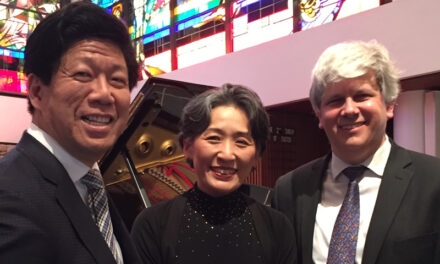This simple medieval legend has been treated many ways by many artists, pitting the devil against the divine and sin against salvation. Simply stated, an aged doctor enters into a pact with the devil to obtain youth and love. The heroine of his quest falls for him (abetted by diabolical intervention) but loses her mind when he tires of her. Murdering (mercifully off-stage in the operatic version) the fruit of their passion, she lies in prison, condemned to the guillotine but never losing her faith in divine forgiveness. While in some versions (Goethe) Faust is a hero, redeemed at the end by good works for humanity, in others he is the villain, discontent with the natural order and ready to sell his soul to the devil in pursuit of passion. And Marguerite — sinner or saint?
French composer Charles Gounod (1818-93) is best known for his many operas, of which three are still heard from time to time: Mireille, Roméo et Juliette, and Faust (1859), one of the 20 most performed operas in the U.S. His student, Georges Bizet, far eclipsed the teacher with his Carmen (1875), although his premature death at age 37 prevented him from witnessing its success. Gounod is probably best known, however, for his setting of the Latin prayer, “Ave Maria,” to the first Prelude of J. S. Bach’s Well-Tempered Clavier.
The original five acts are often telescoped into three, with occasional short pauses for scenery changes. Although this shortens the total evening, it does not interfere with the drama, and, except for omitting most of the fifth act ballet, the music is all present. And it is wonderful music — beautiful, memorable arias, lusty choruses (“Vin ou Bière”), and superb orchestral writing by Gounod. He is very adept at portraying suspense with bassoons and horns playing ominous slow dotted rhythms and introversion with prolonged clarinet cadenzas.
A generous portion of the Charlotte Symphony was seated in the spacious pit of the Belk Theater of the Blumenthal Center, led by Opera Carolina‘s General Director James Meena. Conducting with precise gestures, Maestro Meena was decisive and clear. The ensemble was excellent and for the most part balanced the stage and the singing well, although there were moments where Marguerite’s low register was covered by the orchestra. From where I was sitting, in the first mezzanine, dead center, many of the principal woodwind solos projected too softly in the piano passages throughout the opera. Special mention must be made of the splendid ppp – sotto voce waltz ironically inserted into the closing moments of the opera.
Tenor James Valenti was an elegant and seductive Faust, with a lovely voice and great tessitura, handling with ease the high C at the end of the beautiful aria, “Salut, demeure chaste et pure.” Maureen O’Flynn, making her Opera Carolina debut as the “chaste and pure” Marguerite, looked and acted the part and sounded angelic. One only wished, especially in the last act, that her voice were larger or than the orchestra might be softer. Her second act recounting of the legend of the “Roi de Thulé” followed by famous “Jewel Song” were highlights of the evening and turning points in the unfolding drama of seduction of the innocent.
Her brother and moral defender, Valentin, sung by Corey McKern, also in his Opera Carolina debut, is one of the stronger voices on stage. He eventually dies in her arms, killed in a lopsided duel against Faust (aided by Méphistophélès), but not before cursing her and damning her to hell. Shunned by all, she leaves the stage and perhaps her senses.
The antagonist of the opera, Méphistophélès, is sung by Chester Patton, also his first time on this stage. He is tall, suave, elegant, athletic, and blessed with a beautiful and powerful bass voice. As befits the role, he dominates the stage whenever he is on it. And in this version of the tale, he gets his man in the end. In the beautiful closing scene on an austere stage (reminiscent of Wieland Wagner’s minimal sets for Tristan und Isolde), he envelops Faust in his cloak and slithers off stage while Marguerite, singing her last prayer, casts off her shackles and slowly advances toward the audience. The spotlight narrows gradually to finally show only her face, bathed in a pure white halo. This singularly affecting closing is accompanied in the orchestra by an affirming major chord diminishing into silence as the curtain slowly lowers.











